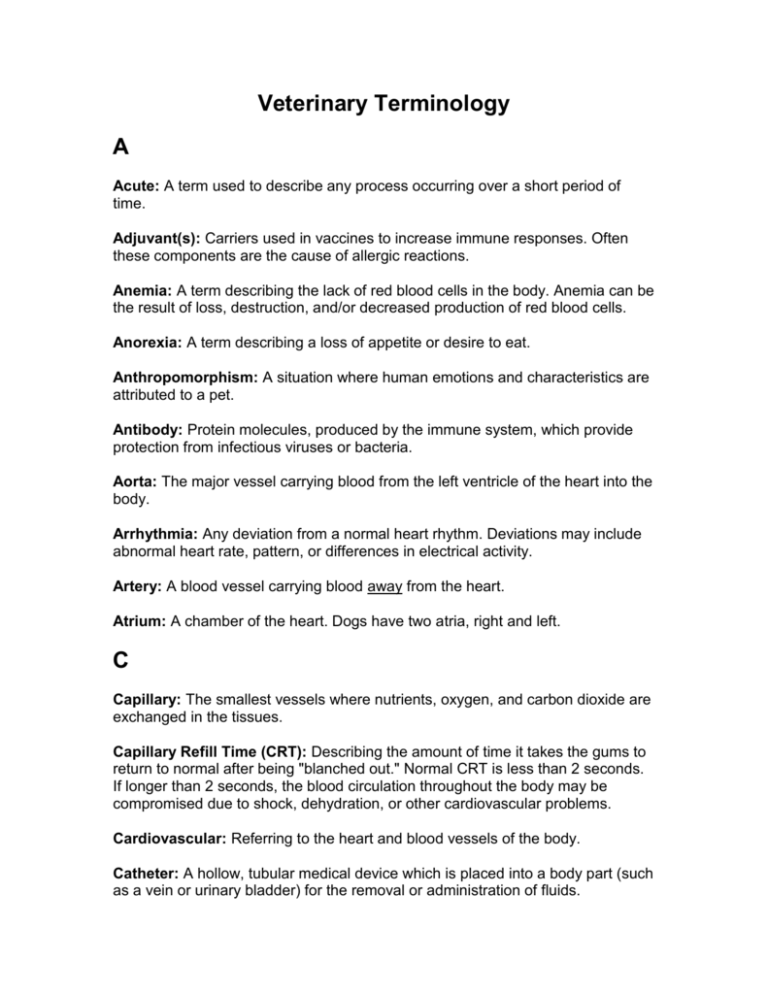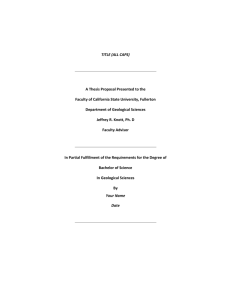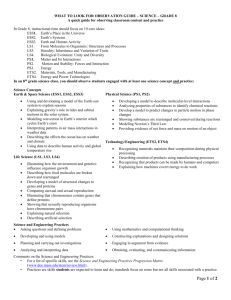Veterinary Terminology
advertisement

Veterinary Terminology A Acute: A term used to describe any process occurring over a short period of time. Adjuvant(s): Carriers used in vaccines to increase immune responses. Often these components are the cause of allergic reactions. Anemia: A term describing the lack of red blood cells in the body. Anemia can be the result of loss, destruction, and/or decreased production of red blood cells. Anorexia: A term describing a loss of appetite or desire to eat. Anthropomorphism: A situation where human emotions and characteristics are attributed to a pet. Antibody: Protein molecules, produced by the immune system, which provide protection from infectious viruses or bacteria. Aorta: The major vessel carrying blood from the left ventricle of the heart into the body. Arrhythmia: Any deviation from a normal heart rhythm. Deviations may include abnormal heart rate, pattern, or differences in electrical activity. Artery: A blood vessel carrying blood away from the heart. Atrium: A chamber of the heart. Dogs have two atria, right and left. C Capillary: The smallest vessels where nutrients, oxygen, and carbon dioxide are exchanged in the tissues. Capillary Refill Time (CRT): Describing the amount of time it takes the gums to return to normal after being "blanched out." Normal CRT is less than 2 seconds. If longer than 2 seconds, the blood circulation throughout the body may be compromised due to shock, dehydration, or other cardiovascular problems. Cardiovascular: Referring to the heart and blood vessels of the body. Catheter: A hollow, tubular medical device which is placed into a body part (such as a vein or urinary bladder) for the removal or administration of fluids. CC: See cubic centimeter. Chronic: A term used to describe any process occurring over a long period of time. Complete Blood Count (CBC): A blood test used to study red and white blood cells. Commonly performed in veterinary medicine, the CBC can help identify problems such as infections or anemia. Congenital: A term meaning present at birth. Birth defects are usually referred to as congenital. Crude Protein: The total amount of protein in a diet, expressed as a percent of the diet. Cubic Centimeter (CC): A volume measurement identical to milliliter (mL). Cystocentesis: A procedure where a needle is placed into the urinary bladder and a sample of urine is removed. Cystoscopy: A procedure where an endoscope is directed into the urinary bladder. D Defecate or Defecation: The act of passing stool from the rectum. Definitive Diagnosis: The precise recognition of a specific disease. Diastole: The resting phase of the heart. During this time the ventricles fill with blood. Distal: Denoting that a structure is further from the main body. For example, the foot is distal to the elbow on a dog’s limb. Diuresis: The act of increasing urine production. This can occur naturally in the animal or can be induced using special drugs or fluid administration. E Echocardiography or Echocardiogram: A technique that examines the heart using ultrasonic sound waves produced by an ultrasound. An image is produced of the valves, muscle walls, and internal structures of the heart. Edema: Referring to fluid swelling that can accumulate anywhere in the body. Electrocardiography or Electrocardiogram (ECG or EKG): A method of examining the heart that measures the electrical changes of the heart during a normal sequence of beats. This test detects irregular patterns and rhythms. Endocarditis: A condition where the endocardium or inner surface of the heart becomes inflamed or irritated. Endoscope: A narrow fiber optic camera that can be used to view the internal structures of an animal. These instruments come in various diameters and lengths, and are equipped with a moveable end that can move left, right, up, and down. Endoscopy: A procedure performed using an endoscope. Energy: The amount of calories available in a diet for growth, activity, or milk production. Extra-Label Use: Using a product for something other than what is specified on the label. F Fecal Flotation: A procedure that is performed by a veterinarian and used to identify various parasite eggs in a fecal sample. Feces: The stool or excrement produced by an animal. Fiber: The portion of a diet that is indigestible or slowly digested. G Gestation: Describing the period of development of the fetus throughout the pregnancy. Glomerulonephritis: Inflammation of the kidney, beginning at the level of the thousands of microscopic glomeruli. The glomeruli are the tiny filters which allow only fluid and toxic compounds to pass from the bloodstream into the urinary tract to be excreted from the body. Gram Negative: A way of categorizing bacteria according to the color (red) they appear when stained by a particular staining process. Some gram negative bacteria include E. coli and Klebsiella. Gram Positive: A way of categorizing bacteria according to the color (blue) they appear when stained by a particular staining process. Some gram positive bacteria include Staphylococcus spp. and Streptococcus spp. H Hemorrhage: A term indicating bleeding or blood loss. Hematuria: A term indicating blood in the urine. The blood may or may not be seen with the naked eye. Histology or Histopathology: Terms describing the process of evaluating specially prepared tissue samples using a microscope. These samples are often taken from tissues collected from a mass or tumor. I Icterus: A term describing a yellow discoloration of the gums and white of the eye that is often associated with liver problems and some types of anemia. Idiopathic: Describing when the exact cause of the problem or disease is not known. IM: See intramuscular. Immunity: A term describing protection from disease that comes as a result of the body’s normal immune system response. The body’s immune system can provide disease protection because of prior vaccinations or previous exposure to an infectious organism. IN: See intranasal. Indications for Use: A term used to identify the situations when a specific product can be used. Intramuscular (IM): A term describing the route of administration of an injection. Use of this term would indicate that the injection should be given through the skin and into a muscle. Intranasal (IN): Referring to the spraying or administering of a solution into the nostrils. Intravenous (IV): A term describing the route of administration of medications or fluids. Use of this term would indicate that the substance should be given into a vein. IV: See intravenous. K Killed Vaccine: A term that means a particular vaccine contains no live diseasecausing components. These vaccines are safe to give to pregnant animals and also to puppies in close association with pregnant animals. L Lethargy or Lethargic: A term describing an animal’s disposition. These animals are slow to react, lack energy, and are often sick. M Melena: Describing a situation where digested blood is found in the feces of an animal. Often the stool appears dark and tarry. Milliliter (mL): A metric volume measurement that is identical to cubic centimeter (cc). mL: See milliliter. Modified Live Virus Vaccine (MLV): A term meaning that a particular vaccine does contain live portions of disease-causing agents. These vaccines should not be given to pregnant animals. Murmur: A term which describes an abnormal heart sound. These are graded from 1-6, with 6 being the loudest murmur. N Necropsy: The animal equivalent to human autopsy, meaning to examine an animal after death for signs that might indicate the cause of death. Necrotic: Referring to decaying tissue. Often the tissue is black, decomposed, and has a bad odor. Neoplasia: Describing any type of cancer in the body. This term is usually associated with some type of mass or lump. Nephritis: A general term describing inflammation of the kidney(s). NSAIDS (Non-steroidal anti-inflammatory): A group of drugs that decreases inflammation, swelling, and pain. By definition, they reduce inflammation, and are not steroids. O O-T-C (Over The Counter): Products that do not require a veterinary prescription to purchase. P Palatable or Palatability: A term describing the taste and texture of a food. A food that is highly palatable has a pleasant taste and texture. Passive Transfer: Acquiring protection against infectious disease from another animal. This commonly occurs when a puppy consumes antibody-rich colostrum from its mother. Failure to have sufficient passive transfer increases the risk of disease. Pathology: Describing the study of tissues for signs of disease. Peritonitis: Referring to inflammation of the internal surface of the abdomen. This condition is often the result of infections and certain diseases. Polydypsia: Describing an abnormal increase in thirst. Polyp: A generic term for a small, raised, and often round mass or bump. Depending on the type of polyp, some are not harmful while others require attention. Polyuria: Describing an abnormal increase in urination. Presumptive Diagnosis: Referring to a situation when the diagnosis is based on a preliminary exam and not on specific testing and results. This diagnosis is often based on the clinician’s experience and on clinical signs that may be very specific for a particular disease. Prognosis: A statement that indicates the chances of an animal having a normal quality of life following a disease or problem. This is reported using the words poor, fair, good, or excellent. Proximal: A term denoting that a structure is closer to the main body. For example, the elbow is proximal to the foot on a dog’s limb. Pyelonephritis: Inflammation of the kidney, beginning at the "pelvis." (The pelvis is the enlarged hollow area inside the kidney where urine pools before entering the ureter.) Pyelonephritis is generally due to a bacterial infection. Q Quarantine: A term meaning to confine and keep an animal from contacting other animals or people. This is essential in many of the infectious diseases that are potentially transmissible to other animals or humans. R Rx (Prescription): Products that require a veterinary prescription to purchase. S SC or SQ: See subcutaneous. Skin Tent: A process where the skin of an animal is gently pinched and pulled outward. A dehydrated animal’s skin will not rapidly return to its normal position or shape. Subcutaneous (SC or SQ): A term indicating the location of an injection. Use of this term would mean the injection should be given under the skin, but not in the muscle. Stool: The feces or excrement produced by an animal. Syncope: A temporary loss of consciousness, usually due to the lack of oxygen to the brain. This is also known as fainting. Systole: Part of the normal beating of the heart where blood is pushed from the ventricles of the heart. This is known as the contraction phase of the heart beat. T Transtracheal Wash: A procedure where the fluid from the lungs is collected and then evaluated. U Umbilicus: The area where the umbilical cord was attached during gestation. This is commonly known as the "belly button." Urethroscopy: An examination of the urethra using an endoscope. Uroliths or Urolithiasis: Describing a variety of stones that are found in the urinary system. These include kidney and bladder stones. V Vein: The blood vessels in the body that carry blood towards the heart. Ventricle: A chamber of the heart that pumps blood to the lungs and the rest of the body. A dog’s heart has two ventricles, left and right. Virulence: Ability that a microorganism has to cause an infection or disease. Microorganisms which have the ability to cause more severe disease are said to be highly virulent. Z Zoonosis or Zoonotic: Terms that are used for any animal disease that can be spread to humans.





